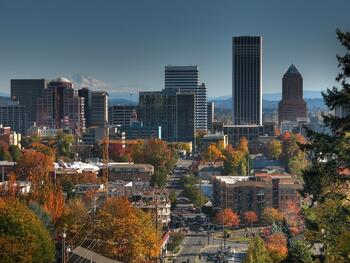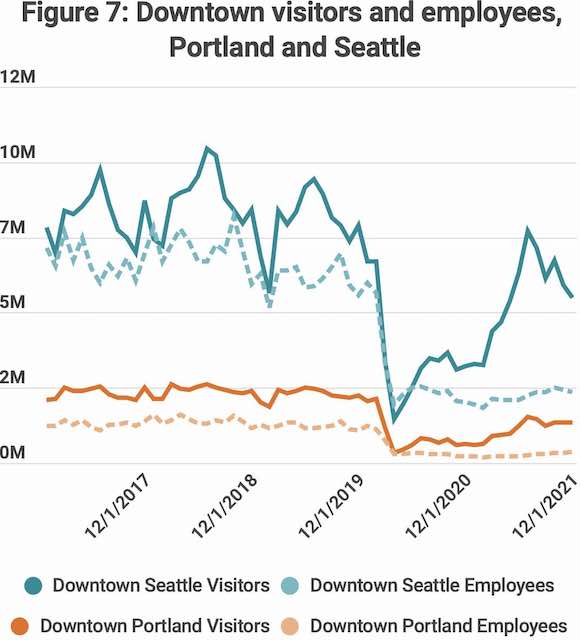
The number of people working in downtown Portland dropped from more than 103,000 in mid-2019 to 13,000 in mid-2020, according to a State of the Economy report recently published by the Portland Business Alliance. The report doesn’t actually show numbers, but the chart below, which I took from the report, can be used to make pretty close estimates.
By the end of 2021, the downtown area had recovered to about 34,000 workers, still less than a third of pre-pandemic numbers. The pandemic may not be the only factor depressing downtown employment: Black Lives Matter protests that began in May 2020 resulted in “numerous instances of arson, looting, vandalism, and injuries,” many of which affected downtown businesses and will probably continue to do so well into the future.
This chart is taken from page 3 of Portland Business Alliance’s State of the Economy report. Click image for a larger view.
The Portland Business Alliance also recently published a downtown business survey that reports, among other things, how people get to work. The 2018 survey found that half of downtown employees got to work on transit, either bus, light rail, or streetcar, while 38 percent drove and 12 percent walked or bicycled. In 2020, the share taking transit fell to 30 percent, and it only gained 2 percent in 2021 while shares of all other modes increased.
In numbers, about 51,000 took transit to work in 2018, falling to 4,000 in 2020 and 11,000 in 2021. Driving (including carpooling) went from 39,000 to 5,000 in 2020 and 14,000 in 2021. Walking and cycling did best of all, going from 12,000 in 2018 to 3,000 in 2020 and 8,000 in 2021. In addition, about 800 people took Uber, Lyft, or scooters to work in 2020, increasing to 1,700 in 2021.
There are two reasons why transit declined more than other modes. First, the high-income people who work downtown are more likely to be able to work at home than the lower-income people who tend to work in other parts of the city. Second, the 70 percent drop in jobs from 2018 to the end of 2021 means a lot less congestion, so many people who once rode transit to avoid congestion are driving instead.
But the big news is simply the smaller number of downtown jobs. There are nearly 70,000 fewer people working downtown than before the pandemic, and more than 40,000 of them are no longer taking transit to work. As I noted last week, I don’t see this as a tragedy, but merely a continuation of long-term trends. Portland would have gotten there eventually anyway, and the sooner people recognize it the sooner we can stop wasting money trying to turn Portland back into a nineteenth-century city.
This piece first appeared on The Antiplanner.
Randal O’Toole, the Antiplanner, is a policy analyst with nearly 50 years of experience reviewing transportation and land-use plans and the author of The Best-Laid Plans: How Government Planning Harms Your Quality of Life, Your Pocketbook, and Your Future.
Photo: David Grant, via Flickr under CC 2.0 License.













